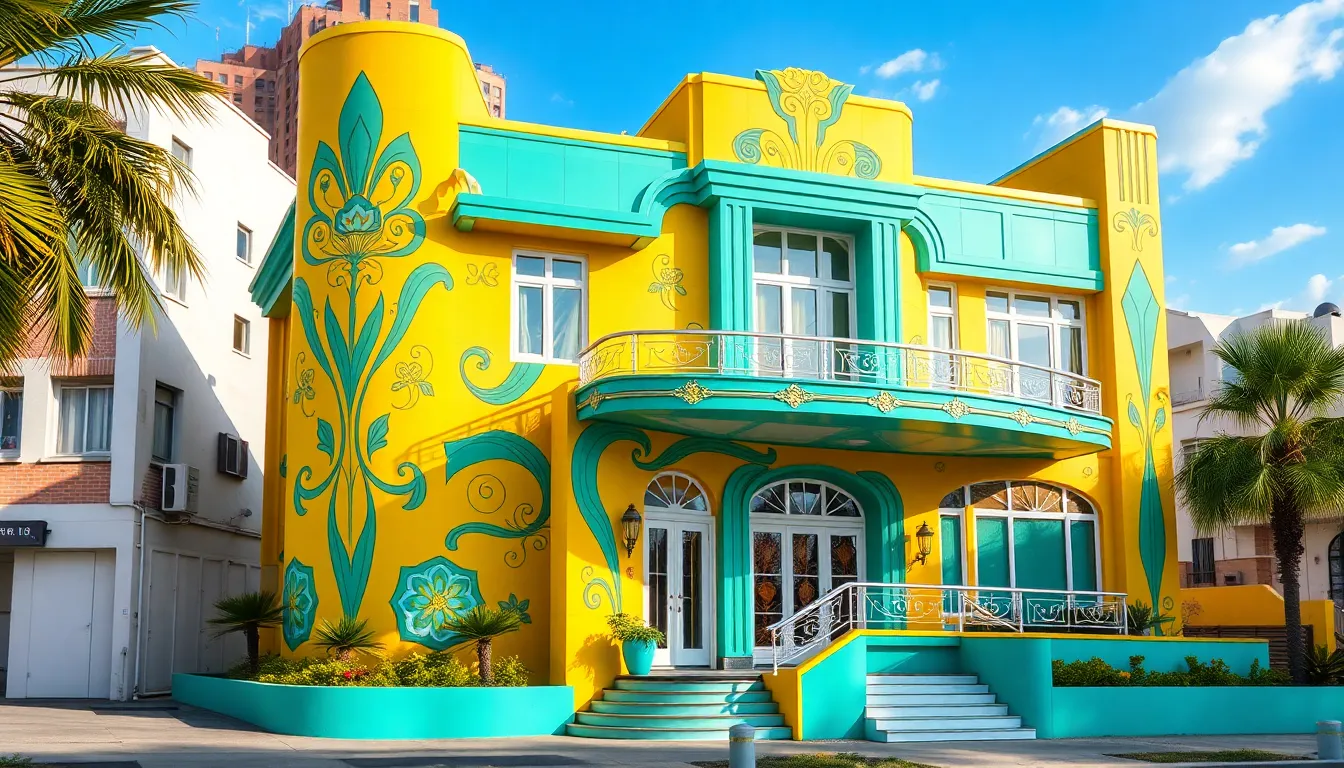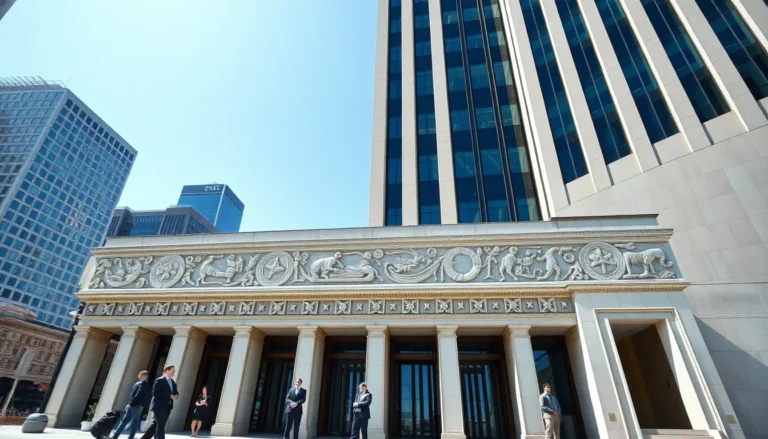Table of Contents
ToggleImagine stepping into a world where elegance meets whimsy, where geometric shapes and vibrant colors dance together in perfect harmony. Art Deco architecture houses are not just buildings; they’re time capsules that whisk you back to the roaring twenties. With their bold lines and intricate details, these homes make a statement that says, “I’m fabulous, and I know it!”
Overview of Art Deco Architecture
Art Deco architecture emerged in the early 20th century, thriving in the 1920s and 1930s. Characterized by bold geometric shapes, vibrant colors, and intricate detailing, this style reflects the cultural dynamism of its time. It draws inspiration from various sources, including ancient Egyptian, Aztec, and modernist influences.
Prominent features of Art Deco houses include zigzag patterns, stylized floral motifs, and ornate facades. Structures often exhibit a streamlined appearance, showcasing technological advancements of the era. Materials used commonly encompass stucco, glass, and metal, enhancing both durability and aesthetic appeal.
The movement gained prominence in urban areas, particularly in cities like Miami, New York, and Los Angeles. In Miami, the Art Deco Historic District boasts over 800 preserved buildings. Walkable neighborhoods display pastel colors and decorative detailing that transport visitors back to the excitement of the period.
Architects of the era, such as William Van Alen and Raymond Hood, contributed significantly to the movement. The Chrysler Building in New York and the Guardian Building in Detroit stand as iconic examples of Art Deco brilliance. Attention to craftsmanship distinguished these structures, with elements like decorative metalwork and unique light fixtures.
Art Deco architecture embodies a spirit of optimism and modernity. It represents progress and innovation during a transformative period in history. The style remains influential today, inspiring contemporary designers and preserving a timeless elegance in urban landscapes.
Key Features of Art Deco Architecture Houses

Art Deco architecture houses showcase distinct characteristics that define their style. These features reflect the vibrancy and innovation of the early 20th century.
Geometric Shapes and Patterns
Geometric shapes and patterns dominate the design of Art Deco homes. Rectangles, triangles, and zigzag motifs create striking visual impressions. Architects often emphasize symmetry and repetition in their designs. Stylized floral elements integrate seamlessly into the overall aesthetic. Art Deco houses frequently boast bold, streamlined forms that convey motion and progress. These geometric embellishments highlight the craftsmanship of the era while remaining timeless in appeal.
Use of Bold Colors
Bold colors play a vital role in the appearance of Art Deco architecture houses. Bright hues like turquoise, yellow, and orange add vibrancy to facades. Contrasting shades enhance the geometric designs, making patterns more striking. Architects often incorporated materials that reflected light, amplifying colors further. These color choices evoke feelings of excitement and celebration, reminiscent of the Roaring Twenties. By prioritizing an eye-catching palette, Art Deco homes stand out in urban landscapes.
Historical Context of Art Deco Architecture
Art Deco architecture thrived during the early 20th century, symbolizing the vibrant spirit of its era. It captured the essence of modernity and social change.
The Rise in Popularity in the 1920s
Art Deco gained immense popularity in the 1920s due to cultural shifts after World War I. Urban populations embraced this style as a reflection of newfound prosperity and optimism. Cities like Miami, New York, and Los Angeles showcased remarkable examples of Art Deco buildings, attracting attention from architects and designers. Iconic structures emerged, embodying the desire for luxury and individuality. Events like the 1925 Exposition Internationale des Arts Décoratifs et Industriels Modernes in Paris propelled Art Deco into the limelight, serving as a celebration of exquisite craftsmanship and modern design.
Influences from Other Architectural Styles
Art Deco drew inspiration from various architectural styles, creating a unique fusion. Ancient Egyptian, Aztec, and modernist elements significantly influenced its development. Geometric shapes and streamlined forms became hallmarks, reflecting advances in technology. Additionally, the ornate detailing in Art Deco structures often resembled decorative motifs from past movements like Beaux-Arts and Cubism. Art Deco architects skillfully merged these elements, resulting in designs that conveyed elegance and sophistication. Influences from diverse sources contributed to the movement’s distinctive identity, helping establish its place in architectural history.
Iconic Examples of Art Deco Architecture Houses
Art Deco architecture houses stand out for their distinctive style and breathtaking designs. Numerous examples around the world showcase the beauty and elegance of this architectural movement.
Notable Buildings Around the World
The Miami Beach Architectural District highlights over 800 Art Deco buildings in vibrant colors and distinct geometric shapes. The Bath Club, overlooking the Atlantic, features a stunning facade adorned with floral motifs. In New York, the iconic Chrysler Building exemplifies Art Deco mastery with its tapered crown and intricate detailing. Chicago’s Palmolive Building showcases smooth lines and decorative elements that celebrate the style’s elegance. The Ritz-Carlton in Montreal adds to the architectural narrative, captivating visitors with its grand entrance and classic features.
Famous Architects of the Art Deco Era
Renowned architects significantly influenced the Art Deco movement. William Van Alen created the Chrysler Building, celebrated for its pioneering design and iconic spire. Raymond Hood crafted the Guardian Building in Detroit, known for its rich colors and intricate mosaics. Other noteworthy figures include Joseph Urban, recognized for his contributions to the Ziegfeld Theatre, and Eliel Saarinen, who designed the Art Deco masterpiece known as the Michigan Central Station. Each architect’s unique vision helped shape an era characterized by innovation and distinct style.
Preservation and Restoration of Art Deco Houses
Restoring Art Deco houses requires careful attention to detail and historical accuracy. Many structures built in this style feature intricate murals, ornamental ironwork, and unique architectural elements that embody their period. Professionals usually focus on preserving these distinctive characteristics during restoration efforts.
Local preservation societies often play a significant role in protecting Art Deco architecture. These organizations work to raise awareness about the historical importance of such buildings and advocate for their maintenance. Engaging the community ensures broader support for preservation initiatives.
Renovation projects frequently prioritize authenticity. When restoring an Art Deco house, using original materials enhances the architectural integrity of the building. For instance, authentic Art Deco tiles and fixtures highlight the style’s vibrant color palette and geometric shapes, further emphasizing its historical context.
Government agencies also contribute to preservation efforts. Many cities seek to designate Art Deco structures as historic landmarks, providing funding or tax incentives for repair and maintenance. This recognition helps secure the future of these architectural treasures in urban environments.
Homeowners can take an active role in preserving their Art Deco properties. Researching the building’s history guides appropriate restoration choices, ensuring that any updates complement the original design. Networking with other owners of Art Deco houses fosters knowledge sharing and encourages best practices in preservation.
The preservation and restoration of Art Deco houses not only protect cultural heritage but also enrich neighborhoods. By showcasing unique architectural styles, these homes remain vital symbols of artistic achievement. Dedicated efforts from individuals, communities, and organizations ensure that the essence of Art Deco continues to inspire future generations.
Art Deco architecture houses stand as vibrant testaments to a dynamic era of creativity and innovation. Their bold geometric designs and striking colors capture the spirit of the Roaring Twenties, inviting admiration and appreciation. As these architectural gems continue to be preserved, they not only reflect historical significance but also contribute to the cultural fabric of modern neighborhoods.
The ongoing efforts to maintain and restore these structures ensure that future generations can experience the unique elegance of Art Deco. By embracing this style, homeowners and communities celebrate a rich heritage while fostering a sense of pride in their architectural landscape. Art Deco’s legacy remains an enduring source of inspiration, blending history with contemporary life in remarkable ways.







